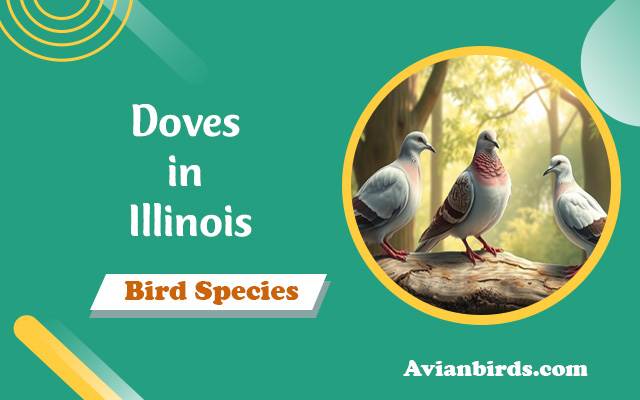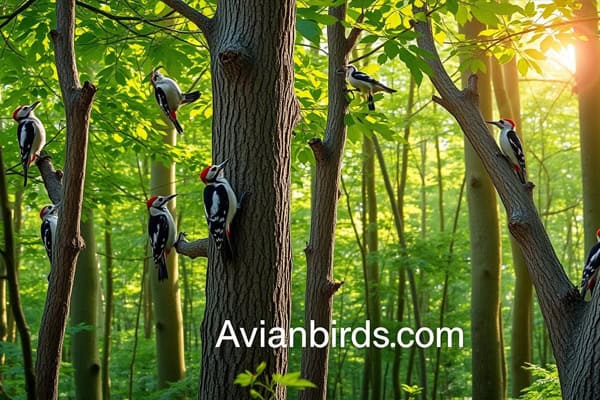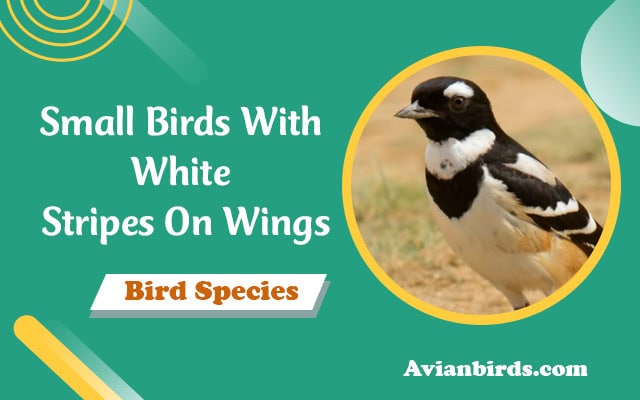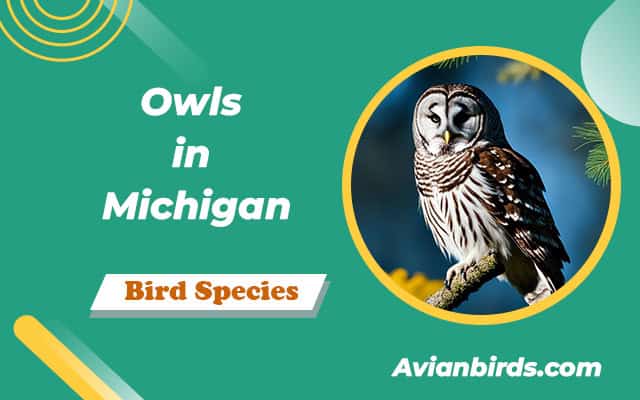5 TYPES OF FALCONS THAT LIVE IN TEXAS!
Ever wondered about the Falcons bird of prey in Texas? The Lone Star State is a paradise for those who love falcons. It’s home to a wide variety of these amazing birds. From the super-fast Peregrine Falcon to the colorful Crested Caracara, Texas’s falcons are truly a sight to see.
But how much do you know about these birds and where they live? Let’s start an exciting journey to learn about the 6 types of falcons in Texas. We’ll discover their interesting behaviors and what makes them special.
Falcons in Texas
Texas is a big and varied state, with many different habitats. You can find everything from coastal marshlands and cypress swamps to deserts and grasslands. This variety makes Texas a top spot for birdwatchers, with over 660 bird species living here.
True Falcons of Texas
This article focuses on the true falcons of the Falco genus in Texas. Also, These birds include the Aplomado Falcon, Prairie Falcon, American Kestrel, Merlin, and the famous Peregrine Falcon. They are the most common falcons in Texas’s diverse landscapes.
The Bat Falcon and Gyrfalcon are rare in Texas, making sightings special for bird lovers. Let’s look at the characteristics and homes of these true falcons in Texas.
Common Falcons Species That Found in Texas
- Aplomado Falcon
- Prairie Falcon
- American Kestrel
- Merlin
- Peregrine Falcon
These falcons are known for their speed, agility, and hunting skills. Also, Each species has special traits and behaviors for surviving in Texas’s varied ecosystems.
| Falcon Species | Habitat | Prey | Conservation Status |
|---|---|---|---|
| Aplomado Falcon | Coastal prairies and grasslands | Small birds, insects, lizards | Endangered |
| Prairie Falcon | Arid and semi-arid regions | Small mammals, birds, reptiles | Least Concern |
| American Kestrel | Open areas, grasslands, and urban environments | Insects, small rodents, and birds | Least Concern |
| Merlin | Open areas, woodlands, and coastal regions | Small birds | Least Concern |
| Peregrine Falcon | Diverse habitats, including urban areas | Medium-sized birds | Least Concern |
Understanding these true falcons helps us appreciate Texas’s rich raptor diversity. Let’s dive deeper into each species in the next sections.
1. Aplomado Falcon
- Scientific name – Falco femoralis
- Lifespan – 8 years (average)
- Size – (38 to 43 cm)
- Weight – (208 to 500 g)
- Wingspan – (76 to 100 cm)
The Aplomado Falcon is a unique bird in Texas, known for its striking looks. It has a medium size, long tail, and wings. This makes it a favorite among birdwatchers and nature lovers.
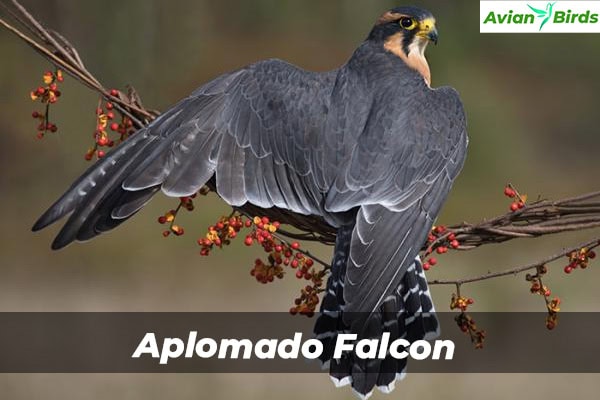
Description and Identification
This falcon is easy to spot with its black and white face stripes. Its belly is tricolored, with a white chest, dark breast band, and a rusty belly. The back is dark brown, and the tail is black and white. The underwings are also dark and barred.
Nesting Habits
Aplomado Falcons like to nest in open areas near marshlands. They take over old nests from other birds like crows and ravens. These nests are often in Yucca plants or trees. The female lays 2 to 4 eggs, which she incubates for 31 to 32 days. The young birds leave the nest after 28 to 35 days.
Diet and Feeding
This falcon eats a wide variety of food, including birds, insects, lizards, and small mammals. It waits patiently or soars high before catching its prey.
Conservation Status
Once common in Texas, the Aplomado Falcon became rare by the 1930s. Conservation efforts released 1,500 captive birds in the 1980s. Now, it’s endangered, with about 100 in Texas. The total population is around 200,000. Pesticides and habitat loss threaten its survival.
Where to Find Aplomado Falcons in Texas
You can find Aplomado Falcons in Texas’s southeast and far west. They live in grasslands and deserts with Mesquite and Yucca plants. The best places to see them are in Mustang Island State Park and others.
2. Prairie Falcon
- Scientific name – Falco mexicanus
- Lifespan – 3 years (average)
- Size – (37 to 47 cm)
- Weight – (420 to 1100 g)
- Wingspan – (90 to 113 cm)
The Prairie Falcon is a stunning bird that lives in Texas’s wild areas. It has a long tail and wings, making it a beautiful sight in the sky. This medium-large falcon is known for its grace as it flies over Texas’s open lands.
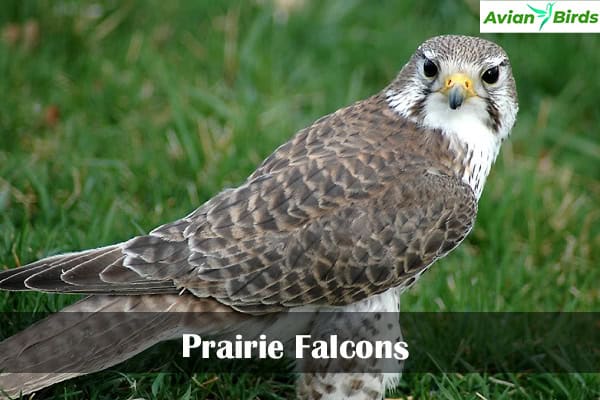
Description and Identification
Male and female Prairie Falcons look alike. They have brown tops, white bottoms, and brown marks on their chest and belly. You can spot them by their pale line above the eye and the brown “mustache” on their face. Their underwing looks dark between the “armpit” and the “wrist.” They make a sound like kik-kik-kik.
Nesting Habits
Prairie Falcons like to nest in open spots, like bluffs and cliffs. Their nests are simple and made from debris. Sometimes, they use nests made by eagles or other birds. These nests are often found in hidden spots, like in a crevice or under an overhang.
They might also nest on buildings, trees, caves, or towers. The female lays 2 to 6 eggs at a time. The eggs are kept warm for 29 to 39 days. After that, the babies stay in the nest for 29 to 47 days before they leave.
Diet and Feeding
Prairie Falcons are skilled hunters. They eat birds, small mammals, and insects. Their diet includes doves, larks, and other birds, as well as ground squirrels and pikas.
Conservation Status
This bird is widespread, with about 80,000 breeding pairs. But, it faces threats like pesticides, hunting, and habitat loss. These dangers come from land changes, fires, mining, and human actions.
Where to Find Prairie Falcons in Texas
You can find Prairie Falcons in Texas’s west, especially in the panhandle. They are seen more in winter but can be found all year. They live in different places like grasslands and deserts. Good spots to see them include:
- Buffalo Lake National Wildlife Refuge
- Aransas National Wildlife Refuge
- Big Bend National Park
- Santa Ana National Wildlife Refuge
Whether you love birds or nature, the Prairie Falcon will amaze you with its flying skills and how it fits into Texas’s varied landscapes.
3. American Kestrel
- Scientific name – Falco sparverius
- Lifespan – 5 years (average), 14 years (maximum recorded)
- Size – (22 to 31 cm)
- Weight – (80 to 165 g)
- Wingspan –(51 to 61 cm)
The American Kestrel is a captivating falcon in Texas. It has a long tail and long wings. The male has slate-blue wings and a rusty back. The female is rusty all over with black bars on top. Both have a grey crown and dark stripes under the eyes.
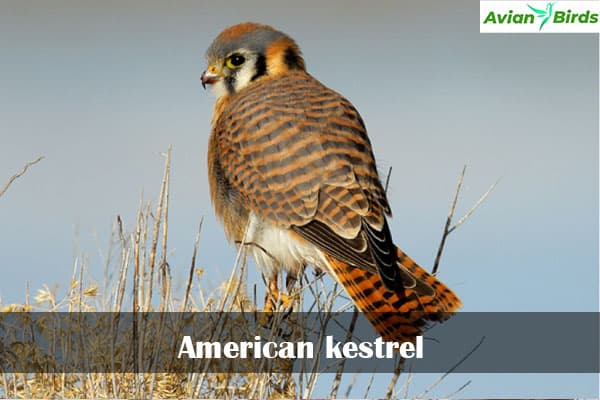
Description and Identification
This falcon makes a call like “klee” or “killy.” It’s a small bird that soars and hovers with skill. It looks for its food with ease.
Nesting Habits
American Kestrels nest in open areas. They use old woodpecker holes, tree cavities, and rock crevices. They also use nest boxes and building corners. Trees near woodlands or open spaces are their favorite spots.
The female lays 4 to 5 eggs. She might lay up to two clutches a season. The eggs hatch after 26 to 32 days, and the young birds leave the nest after 28 to 31 days.
Diet and Feeding
American Kestrels eat a variety of things. They hunt cicadas, beetles, and spiders. They also eat songbirds, snakes, and small mammals like mice.
Conservation Status
Despite having many birds, the American Kestrel’s numbers have dropped by 53% in 50 years. This is due to lost homes from tree cutting and farming. Many of their food sources are also harmed by pesticides.
“The American Kestrel is a true marvel of nature, with its striking plumage and remarkable hunting prowess. However, we must remain vigilant in our efforts to protect this species and its vital role within the Texas ecosystem.”
4. Merlin
- Scientific name – Falco peregrinus
- Lifespan – 13 years (average)
- Size – (36 to 49 cm)
- Weight – (530 to 1600 g)
- Wingspan – (100 to 110 cm)
Merlins are small birds in the falcon family, about the size of a Mourning Dove. They have a blueish-gray to black back, wings, and head, and a buffy to brown underside. Their colors can vary by region, but they often have a white eyebrow stripe.

Description and Identification
Merlins are fast and compact falcons with a unique look. They are smaller than other falcons, making them easy to spot. They have a long, tapered tail for quick turns while hunting. Their wings are short and pointed, perfect for fast speeds.
Habitat and Range
Merlins spend their winters in Northern South America, Central America, Mexico, the Southeastern U.S., and the Western U.S. They move north in spring, reaching the Northern U.S., Canada, and Alaska. Some stay in the Northwestern U.S. and Southwestern Alaska all year, and a few may stay in Northern states through winter.
Hunting Behavior and Diet
Merlins eat small birds like waxwings, sparrows, and shorebirds, as well as insects and rodents. They are known for their fast hunting, often surprising prey with a sudden dive or chase. Their agility and speed help them catch prey in mid-air.
Nesting Habits
Merlins don’t build their nests; they use old nests from other birds like crows, hawks, and magpies. They also nest in tree cavities or on building or cliff ledges. Both parents take turns incubating eggs and feeding the young, and they lay 3-5 eggs.
Read Our Previous Articles:
5. Crested Caracara
The Crested Caracara is a unique bird in the falcon family, also known as the “Mexican Eagle.” It has a white face and neck, a black crest, and a brown body with a white undertail. Its bill is gray and orange, making it stand out. When flying, it shows white marks on its wing tips.
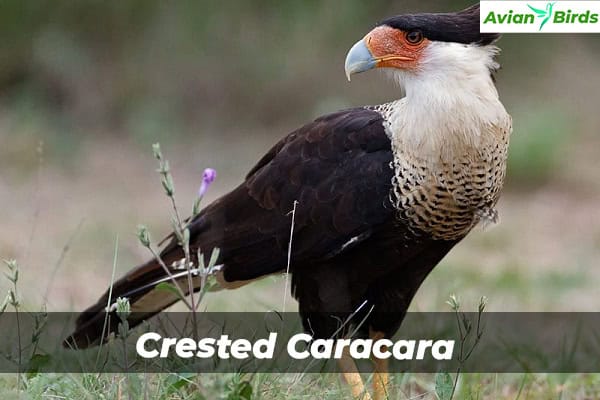
Range and Habitat
Crested Caracaras live all year in much of South and Central America, except for Brazil’s dense rainforests. In the U.S., they are found in Florida, Texas, and Arizona. In Texas, they like open areas with little ground cover, like farms, and places with lots of food, like dumps.
Diet and Foraging Habits
These birds eat many things, from insects to small mammals and carrion. They often eat with other birds like vultures and gulls. They also follow farm equipment to catch insects and rodents.
| Prey | Feeding Behavior |
|---|---|
| Insects | Scavenge and follow farm equipment |
| Reptiles | Opportunistic hunters |
| Birds | Scavenge and hunt small prey |
| Small Mammals | Scavenge and hunt small prey |
| Carrion | Scavenge and feed on dead animals |
The Crested Caracara is adaptable and eats a wide variety of foods. Its unique look and how it finds food make it interesting. It shows the diversity of raptors in Texas.
Final Thoughts
Texas is home to many falcon species, each with unique traits. From the fast Peregrine Falcon to the colorful Crested Caracara, these birds are key to the state’s ecosystems. Learning about their habitats, nests, and diets helps us protect them for the future.
If you love birdwatching or nature, Texas’s falcons will amaze you. They fly over the state’s varied landscapes, showing us the beauty of nature. Let’s keep learning about and celebrating these birds, keeping them in our skies for more years.
The falcons of Texas live in places like West Texas canyons and coastal marshes. Protecting these birds helps us save a big part of Texas’s nature. Let’s enjoy watching, studying, and valuing the falcons above us. Let’s work to keep them safe for future generations.


